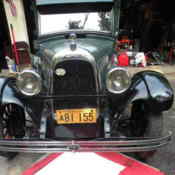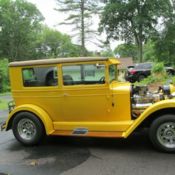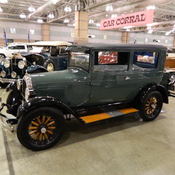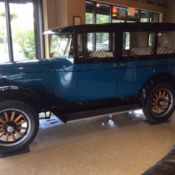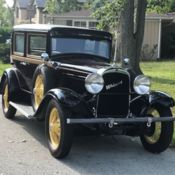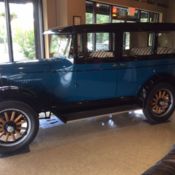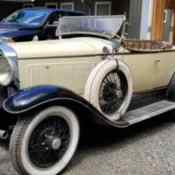1928 Overland Whippet
1928 Willys
1928 Willys Overland Whippet
AUTOCHOICE is proud to represent a rare 1928 Overland Whippet by Willies! Never seen one before today. I must say, was very impressed with the condition and how easy it started. The interior is very well done. With little exception, the exterior looks nice with an exception to rust area on the drivers side just behind the left front wheel. You can see the area. Other than service rust on the under belly, the car is a very good driver. This is a perfect 20' car, in other words it looks good from as distance of 20 feet. The owner passed over a year ago and was bought in his golden years because it Brought to him pleasant memories of his past. This was the exact car he grew up with and it brought sweet memories of the past. His son said he would set outside in the garage where it was parked and look at it for hours just before he passed. If you are looking for a good driver and something different, this is the car for you. It would be perfect to drive in parades and those pleasant sunny weekend days in the summer. Please call Don at (509) 301-1498 (voice/text) with your questions and shipping quotes. NOTE: Never heard about a Overland Whippet by Willies like me? Well, here is from Wikileaks some education for you. A 1923 Willys-Overland Model 64 at the Vintage Car Museum & Event Center in Weatherford, TexasIn 1908, John Willys bought the Overland Automotive Division of Standard Wheel Company and in 1912 renamed it Willys-Overland Motor Company. From 1912 to 1918, Willys was the second-largest producer of automobiles in the United States after Ford Motor Company.
In 1913, Willys acquired a license to build the Charles Knight's sleeve-valve engine which it used in cars bearing the Willys-Knight nameplate. In the mid-1920s, Willys also acquired the F.B. Stearns Company of Cleveland and assumed continued production of the Stearns-Knight luxury car, as well.
John Willys acquired the Electric Auto-Lite Company in 1914 and in 1917 formed the Willys Corporation to act as his holding company. In 1916, it acquired the Russell Motor Car Company of Toronto, Ontario, by 1917, New Process Gear, and in 1919 acquired the Duesenberg Motors Company plant in Elizabeth, New Jersey. The New Jersey plant was replaced by a new, larger facility in Indianapolis, and was to be the site of production for a new Willys Six at an adjacent site, but the depression of 1920–21 brought the Willys Corporation to its knees. The bankers hired Walter P. Chrysler to sort out the mess and the first model to go was the Willys Six, deemed an engineering disaster. Chrysler had three auto engineers: Owen Skelton, Carl Breer, and Fred Zeder (later nicknamed The Three Musketeers) begin work on a new car, commonly referred to as the Chrysler Six.[2]
To raise cash needed to pay off debts, many of the Willys Corporation assets were put on the auction block. The Elizabeth plant and the Chrysler Six prototype were sold to William C. Durant, then in the process of building a new, third empire.[3] The plant built Durant's low-priced Star, while the Chrysler Six prototype was substantially reworked to become the 1923 Flint.[3]
Walter Chrysler and the three engineers who had been working on the Chrysler Six all moved on to Maxwell-Chalmers where they continued their work, ultimately launching the six-cylinder Chrysler in January 1924.[4] (In 1925, the Maxwell car company became the Chrysler Corporation.)
A Willys-Overland Whippet badge 1928 Willys-Overland dealer in Arkansas, circa 1930–1945In 1926, Willys-Overland introduced a new line of small cars named Willys-Overland Whippet. In the economic depression of the 1930s, a number of Willys automotive brands faltered. Stearns-Knight was liquidated in 1929. Whippet production ended in 1931; its models were replaced by the Willys Six and Eight. Production of the Willys-Knight ended in 1933.
In 1932, Ward M. Canaday, who beginning in 1916 had done advertising for the company before becoming a full-time employee, had taken on the role of chairman. He helped guide the company through its current receivership.[5]
At this time, Willys decided to clear the boards and produce two new models– the 4-cylinder Willys 77 and the 6-cylinder Willys 99– but since the firm was once again on the verge of bankruptcy, only the 77 went into production. It was forced to sell its Canadian subsidiary, itself in weak financial shape, and started a massive reorganization. JOnly the main assembly plant and some smaller factories remained the property of Willys-Overland. The other assets were sold off to a new holding company that leased some of the properties back to W-O. The parent company was thus able to ride out the storm.
In 1936, the Willys-Overland Motor Company was reorganized as Willys-Overland Motors.
In 1937, Willys redesigned the 4-cylinder model. It gained a semistreamlined body with a slanted windshield, headlamps integrally embedded into the fenders, and a one-piece, rounded hood transversely hinged at the rear.
For 1939, the Model 39 featured Lockheed hydraulic brakes, a two-inch increase in wheelbase to 102 inches and an improved 134 DID four-cylinder engine[6] with power increased from 48 to 61hp.[7] The Model 39 was marketed as an Overland and as a Willys Overland rather than as a Willys.[7]
In 1929, the company built a factory that built vehicles located at what is now 6201 Randolph Street, Commerce City, California. During the war, the factory built aircraft assemblies for Hudson Bombers. When the war ended, the factory resumed automobile production and was one of two locations to build the first CJ2A, as well as the Willys Aero. The factory was closed in 1954. The location is now occupied by Prologis Eaves Distribution Center.[8]
Willys-Overland was one of several bidders when the War Department sought an automaker that could begin rapid production of a lightweight truck based on a design by American Bantam.
In 1938, Joseph W. Frazer had joined Willys from Chrysler as chief executive. He saw a need to improve the firm's 4-cylinder engine to handle the abuse to which the Jeep would be subjected. This objective was brilliantly achieved by ex-Studebakerchief engineer Delmar "Barney" Roos, who wanted
Production of the Willys MB, better known as Jeep, began in 1941, shared between Willys, Ford, and American Bantam. 8,598 units were produced that year and 359,851 units before the end of World War II. Willys-Overland ranked 48th among United States corporations in the value of World War II military production contracts.[10] In total, 653,568 military Jeeps were manufactured.
The origin of the name "Jeep" has been debated for many years. Some people believe "Jeep" is a phonetic pronunciation of the abbreviation GP, from "General Purpose", that was used as part of the official Army nomenclature. The first documented use of the word "Jeep" was the name of a character Eugene the Jeep in the Popeye comic strip, known for his supernatural abilities (e.g. walking through walls). It was also the name of a small tractor supplied to the U.S. Army by Minneapolis-Moline in 1937.[11] Whatever the source, the name stuck and on February 13, 1943, Willys-Overland filed a trademark application on the use of the term "Jeep" with the U.S Patent Office.[12] After several denials by the patent office and appeals by Willys-Overland, the trademark "Jeep" was finally awarded to the company on June 13, 1950.[13]
After the war, Willys did not resume production of its passenger-car models, choosing instead to concentrate on Jeeps and Jeep-based vehicles. The first postwar Willys product was the CJ-2A, an MB stripped of obviously military features, particularly the blackout lighting, and with the addition of a tailgate.
Willys initially struggled to find a market for the vehicle, first attempting to sell it primarily as an alternative to the farm tractor. Tractors were in short supply, having been out of production during the war. However, sales of the "Agri-Jeep" never took off, mainly because it was too light to provide adequate draft.
The CJ-2A was among the first civilian vehicles of any kind to be equipped with four-wheel drive from the factory, and it gained popularity among farmers, ranchers, hunters, and others who needed a lightweight vehicle for use on unimproved roads and trails.
In 1946, a year after the introduction of the CJ-2A, Willys produced the Willys "Jeep" Utility Wagon based on the same engine and transmission, with clear styling influence from the CJ-2A Jeep. The next year came a "Jeep" Utility Truck with four-wheel drive. In 1948, the wagon was available in four-wheel drive, making it the ancestor of all sport utility vehicles.
Willys planned to re-enter the passenger car market in 1947 with the Willys 6–70 sedan. Its name came from the fact it was powered by a 6-cylinder engine that produced 70hp. The 6–70 was touted as the 'first stock car' in America that offered independent suspension on all four wheels, but it never entered production.[14]
In 1948, under a contract from the US Army, Willys produced a small one-man four-wheeled utility vehicle called the Jungle Burden Carrier which evolved into the M274 Utility ½-ton vehicle.
Willys later produced the M38 Jeep for the U.S. Army, and continued the CJ series of civilian Jeeps. One variation was the Jeepster, which came with a 4-cylinder or 6-cylinder engine, but only with two-wheel drive to the rear.
- Condition: Used
- Make: Willys
- SubModel: Whippet
- Type: Sedan
- Doors: 4
- Year: 1928
- Mileage: 17,442
- VIN: 96250173
- Color: Green
- Engine size: 4
- Fuel: Gas
- Transmission: Manual
- Drivetrain: Rear Wheel Drive
- Interior color: Tan
- Vehicle Title: Clear Want to buy? Contact seller!





